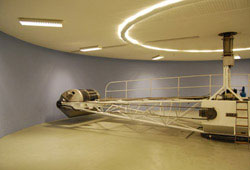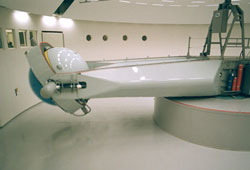Experimental facilities
To a large extent, the equipment/facilities used at the Division of Environmental Physiology has been developed to cope with physiological problems that humans encounter during flying or diving.

Centrifuges
The gondola centrifuge in Solna, which at a peripheral speed of 117 km/h generates a centrifugal force fifteen times higher than the gravity force vector (15 G), was constructed because of the great number of military aircraft accidents induced by pilot loosing consciousness during advanced flying. In the centrifuge pilots could practice techniques to maintain adequate arterial pressure in the brain during exposure to high G loads. The centrifuge is, however, mainly used for research and development, for instance for development of G-protective equipment and for studies concerning basic physiology, e.g. circulatory, respiratory and vestibular functions.

The Division of Environmental Physiology conducts experimental studies also in the human-use centrifuge at Malmslätt close to Linköping. With a radius of 9.1 m (from the center of rotation to the center of the gondola) and a main engine weighing 90,000 kg this centrifuge has a capacity to accelerate to a peripheral speed of 150 km/h within a second. The gondola is equipped with one of the worlds most advanced flight simulators, termed “Dynamic Flight Simulator, DFS”, allowing the pilot/test subject to "fly" high-performance aircraft in a virtual surrounding whilst controling the G-force in the head-seat-direction by simulating turns with varying radius and at different velocities. The research conducted in this facility predominantly deals with risk factors encountered during military operations in high-performance aircraft and in helicopters, for instance G-induced loss of consciousness and spatial disorientation. Equipped with separate gimbal engines, the gondola can move (roll and pitch) irrespective of the resulting gravitoinertial vector, offering unique possibilities of investigating how human spatial orientation is governed by the different components of the vestibular system.
Pressure chambers and immersion pools
The predominant tools used to investigate the effects of changed ambient pressure are hyper- and hypobaric chambers. At the KTH laboratory in Solna, the Environmental Physiology group has both a hypobaric chamber, in which high-altitude exposures (up to >20 000 masl) are simulated, and a hyperbaric chamber, in which diving is simulated (150 m Sea water). The Environmental Physiology group has a close collaboration with the Swedish Navy and hence has access to a swim flume, indoor pools and a free-escape tower located at the Diving and Naval Medicine Center (DNC) in Karlskrona as well as the large hyperbaric facility.

